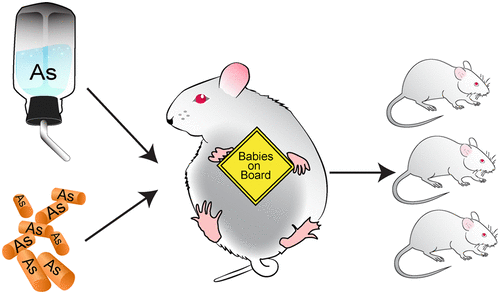当前位置:
X-MOL 学术
›
Chem. Res. Toxicol.
›
论文详情
Our official English website, www.x-mol.net, welcomes your
feedback! (Note: you will need to create a separate account there.)
Dose and Diet – Sources of Arsenic Intake in Mouse in Utero Exposure Scenarios
Chemical Research in Toxicology ( IF 3.7 ) Pub Date : 2018-01-02 00:00:00 , DOI: 10.1021/acs.chemrestox.7b00309 Manuela Murko 1 , Brittany Elek 2 , Miroslav Styblo 3 , David J. Thomas 2 , Kevin A. Francesconi 1
Chemical Research in Toxicology ( IF 3.7 ) Pub Date : 2018-01-02 00:00:00 , DOI: 10.1021/acs.chemrestox.7b00309 Manuela Murko 1 , Brittany Elek 2 , Miroslav Styblo 3 , David J. Thomas 2 , Kevin A. Francesconi 1
Affiliation

|
In humans, early life exposure to inorganic arsenic is associated with adverse health effects. Inorganic arsenic in utero or in early postnatal life also produces adverse health effects in offspring of pregnant mice that consumed drinking water containing low part per billion levels of inorganic arsenic. Because aggregate exposure of pregnant mice to inorganic arsenic from both drinking water and food has not been fully evaluated in experimental studies, quantifying arsenic exposure of the developing mouse is problematic. Here, we determined levels of total arsenic and arsenic species in natural ingredient rodent diets that are composed of many plant and animal-derived foodstuffs and in a purified ingredient rodent diet that is composed of a more restricted mixture of foodstuffs. In natural ingredient diets, total arsenic levels ranged from ∼60 to ∼400 parts per billion, and in the purified ingredient diet, total arsenic level was 13 parts per billion. Inorganic arsenic was the predominant arsenic species in trifluoroacetic acid extracts of each diet. Various exposure scenarios were evaluated using information on inorganic arsenic levels in diet and drinking water and on daily food and water consumption of pregnant mice. In a scenario in which pregnant mice consumed drinking water with 10 parts per billion of inorganic arsenic and a natural ingredient diet containing 89 parts per billion of inorganic arsenic, drinking water contributed only ∼20% of inorganic arsenic intake. Quantitation of arsenic species in diets used in studies in which drinking water is the nominal source of arsenic exposure provides more accurate dosimetry and improves understanding of dose–response relations. Use of purified ingredient diets will minimize the discrepancy between the target dosage level and the actual dosage level attained in utero exposure studies designed to evaluate effects of low level exposure to inorganic arsenic.
中文翻译:

剂量和饮食-子宫暴露场景中小鼠砷的摄入来源
在人类中,生命早期暴露于无机砷与不良健康影响相关。子宫内的无机砷或在出生后的早期生活中,对喝了含有十亿分之几的无机砷的饮用水的怀孕小鼠的后代也会产生不利的健康影响。由于尚未在实验研究中完全评估妊娠小鼠从饮用水和食物中接触无机砷的总量,因此量化发育中小鼠的砷暴露是有问题的。在这里,我们确定了由许多植物和动物衍生的食物组成的天然成分啮齿动物饮食和由更加严格的食物混合物组成的纯净成分啮齿动物饮食中总砷和砷的含量。在天然成分的日粮中,总砷含量为约十亿分之一至60至约四十亿份,而在纯净成分的日粮中,总砷含量为十亿分之十三。每种饮食中三氟乙酸提取物中的主要砷是无机砷。使用有关饮食和饮用水中无机砷含量以及怀孕小鼠的日常食物和水消耗量的信息,评估了各种暴露情况。在怀孕的小鼠消耗的饮用水中含有十亿分之十的无机砷,而天然成分饮食含有十亿分之十的无机砷的情况下,饮用水仅贡献了约20%的无机砷摄入量。在以饮用水为砷暴露标称来源的研究中,饮食中砷种类的定量提供了更准确的剂量学,并增进了对剂量反应关系的理解。在子宫内暴露研究中,旨在评估低水平暴露于无机砷的影响。
更新日期:2018-01-02
中文翻译:

剂量和饮食-子宫暴露场景中小鼠砷的摄入来源
在人类中,生命早期暴露于无机砷与不良健康影响相关。子宫内的无机砷或在出生后的早期生活中,对喝了含有十亿分之几的无机砷的饮用水的怀孕小鼠的后代也会产生不利的健康影响。由于尚未在实验研究中完全评估妊娠小鼠从饮用水和食物中接触无机砷的总量,因此量化发育中小鼠的砷暴露是有问题的。在这里,我们确定了由许多植物和动物衍生的食物组成的天然成分啮齿动物饮食和由更加严格的食物混合物组成的纯净成分啮齿动物饮食中总砷和砷的含量。在天然成分的日粮中,总砷含量为约十亿分之一至60至约四十亿份,而在纯净成分的日粮中,总砷含量为十亿分之十三。每种饮食中三氟乙酸提取物中的主要砷是无机砷。使用有关饮食和饮用水中无机砷含量以及怀孕小鼠的日常食物和水消耗量的信息,评估了各种暴露情况。在怀孕的小鼠消耗的饮用水中含有十亿分之十的无机砷,而天然成分饮食含有十亿分之十的无机砷的情况下,饮用水仅贡献了约20%的无机砷摄入量。在以饮用水为砷暴露标称来源的研究中,饮食中砷种类的定量提供了更准确的剂量学,并增进了对剂量反应关系的理解。在子宫内暴露研究中,旨在评估低水平暴露于无机砷的影响。











































 京公网安备 11010802027423号
京公网安备 11010802027423号